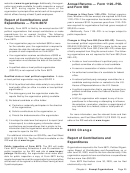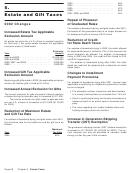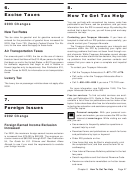Publication 553 - Highlights Of 2002 Tax Changes Page 17
ADVERTISEMENT
actions that result in, or are likely to result in, a gross
Later Changes
loss (before netting any gain against it) of at least
$10 million in any single tax year or $20 million in
any combination of tax years. For partnerships and S
corporations, this category includes transactions that
Extension of Placed-in-Service Date
result in, or are likely to result in, a gross loss (before
netting any gain against it) of at least $5 million in
To qualify for the special depreciation allowance, your
any single tax year or $10 million in any combination
property must meet certain tests, including the placed in
of tax years.
service date test, as well as certain other requirements
(covered in chapter 3 of Publication 946, How To Depreci-
5) Transactions with significant book-tax differ-
ate Property). To meet the placed in service date test, your
ences. This category includes transactions in which
property must generally be placed in service for use in your
the treatment for federal income tax purposes of any
trade or business or for the production of income after
income, deduction, or credit item or items from the
September 10, 2001, and before January 1, 2005. How-
transaction differs, or is reasonably expected to dif-
ever, certain property placed in service before January 1,
fer, by more than $10 million on a gross basis from
2006, may meet this test. Transportation property and
the treatment of these items for book purposes in
property with a recovery period of 10 years or longer meet
any tax year. This category applies only to:
the test if one of the following applies.
a) Reporting companies under the Securities Ex-
•
The property has an estimated production period of
change Act and related entities (as defined in
more than 2 years.
sections 267(b) and 707(b) of the Internal Reve-
•
nue Code), or
The property has an estimated production period of
more than 1 year and it costs more than $1 million.
b) Business entities that have $100 million or more
in gross assets, including the assets of all related
Transportation property is any tangible personal prop-
entities (as defined in sections 267(b) and 707(b)
erty used in the trade or business of transporting persons
of the Internal Revenue Code).
or property.
For property that qualifies for the special depreciation
6) Transactions with brief asset holding periods.
allowance solely because of the one-year extension of the
This category includes transactions with both of the
placed in service date, only the part of the basis attributa-
following characteristics.
ble to manufacture, construction, or production before
September 11, 2004, is eligible for the special depreciation
a) The transaction involves an asset(s) held by an
allowance.
investor for less than 45 days. To determine the
asset’s holding period, see section 246(c)(3) and
Special Liberty Zone Depreciation
(4) of the Internal Revenue Code.
Allowance for New and Used Property
b) The transaction results in a tax credit (including a
foreign tax credit) exceeding $250,000.
You can claim the special Liberty Zone depreciation allow-
ance (an additional 30% depreciation deduction) for used
More information. For more information and excep-
property that you acquire after September 10, 2001, if the
tions to these rules, see Form 8886 and its instructions.
property meets the requirements for qualified Liberty Zone
For the disclosure rules that apply to transactions
property. You will be able to claim the allowance for both
entered into before 2003, see Tax Shelter Disclosure
new and used property that you acquire after September
Statement under 2002 Changes.
10, 2004, provided the property meets the other require-
ments for qualified Liberty Zone property. See chapter 3 in
At the time this publication was being prepared
!
Publication 946, How To Depreciate Property.
for print, the regulations relating to reportable
transactions were expected to be revised. The
CAUTION
Depreciation of Property
revised regulations will permit taxpayers who entered into
transactions after 2002 and before the filing date of the
Used on Indian Reservations
revised regulations to elect to apply the revised regulations
instead of the rules described here.
The special depreciation rules that apply to qualified prop-
erty used on an Indian reservation were scheduled to
expire for property placed in service after 2003. These
special rules have been extended to include property
placed in service in 2004. For more information about
these rules, see Publication 946, How To Depreciate Prop-
erty.
Chapter 2 Tax Changes for Businesses
Page 17
ADVERTISEMENT
0 votes
Related Articles
Related forms
Related Categories
Parent category: Financial
 1
1 2
2 3
3 4
4 5
5 6
6 7
7 8
8 9
9 10
10 11
11 12
12 13
13 14
14 15
15 16
16 17
17 18
18 19
19 20
20 21
21 22
22 23
23 24
24 25
25 26
26 27
27 28
28 29
29 30
30 31
31








